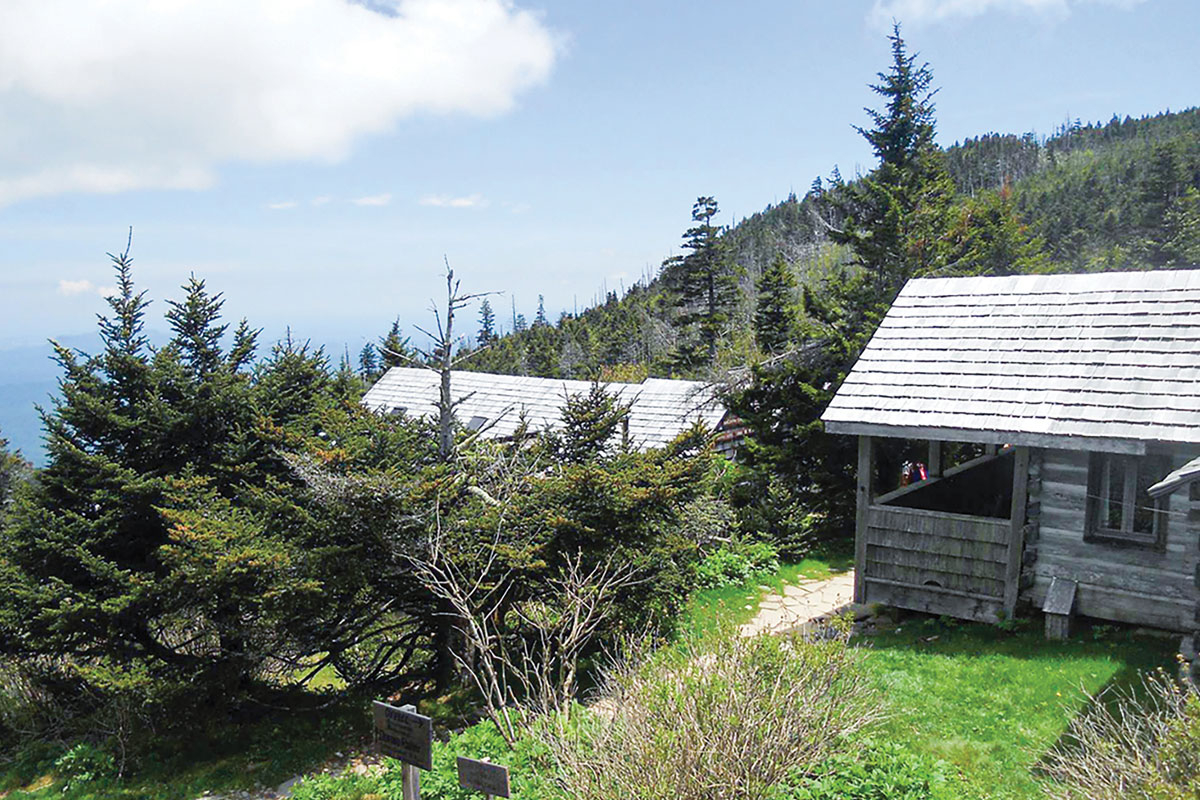Waynesville leaders caught between salt factory and irked neighbors
Giles Chemical pledged last week to do what it could to appease neighbors fed up with intrusive truck traffic on their town streets, but residents maintain the small industry has outgrown its location.
Throughout the day, trucks traveling to and from Giles Chemical to pick up or drop off loads have caused headaches for neighbors. Some truck drivers routinely park their trucks in the road in front of Giles’ Smather Street warehouse, blocking traffic and causing potential safety hazards.
However, all parties involved — including the Waynesville town board — hope “No Parking” signs will help remedy residents’ concerns about tractor trailers, which also end up with their wheels in people’s yards and driveways.
“Keep your fanny off my property,” joked Mayor Gavin Brown as the board discussed posting the new signage.
Town leaders agreed to put up no parking signs along the nearly 1.5-mile stretch of Smathers Street between Plott Creek Road and Commerce Street. That in turn will allow police to ticket any vehicles stopped or idled on the road.
“Cops can make some money off these guys,” said Earl Bradley, owner of Earl’s Automotive on Smathers Street.
It will take the town about a month to post the signs.
In the meantime, Giles Chemical has posted its own signs attempting to corral truck traffic and prevent jams. The company agreed to post such signs last spring.
Signs now direct all tractor trailers to a staging area and instructs truckers to call for questions or further directions.
The hope is that truck drivers will idle in the off-street staging area until the warehouse’s load dock is clear. Giles will then inform the driver when he or she access the dock unimpeded.
The process aims to keep traffic flowing on Smathers Street and prevent tractor-trailers from blocking the road.
“I think that’s a good idea,” said Paul Benson, Waynesville’s town planner. “That’s going to be a hard problem to solve. Honestly, it will continue to be a problem.”
The no parking sign proposal resurfaced as Giles Chemical seeks zoning approval from the town. Giles current zoning classification prevents it from expanding at its current site.
It was rezoned when the town revamped its land-use standards and now wants to be rezoned as commercial-industrial, which would allow for future expansion.
The rezoning was an “unintended oversight,” said Patrick Bradshaw, who sat on the land-use plan review committee.
Heavy industrial technically isn’t allowed in the downtown central business district. Giles’ operations were grandfathered in but can’t expand beyond their current footprint without town approval.
“We simply need our permitted use to be reinstated,” said Matt Haynes, director of manufacturing.
The rezoning conundrum
Giles Chemical will have to wait another couple of weeks to hear whether Waynesville’s Board of Aldermen will approve or deny their request for rezoning, however.
During the meeting, Haynes reminded attendees and the aldermen that Giles, the leading producer of Epsom salt in the U.S., contributes to the local economy.
“Giles has been an honorable and valuable member of this community for a long time,” he said.
About seven Waynesville residents attended the board meeting last week and spoke out against Giles’ rezoning request.
“They have outgrown,” said Mark Yops, a resident of Love Lane, adding that he is “constantly having to wait for the semi-trucks.”
The rezoning would be “more disruptive,” he said.
Earl Bradley, owner of Earl’s Automotive on Smathers Street, said that he must already deal with truckers blocking the road and using his property to back into Giles’ docking area.
“I don’t see it being any different if they get to build more,” he said.
Bradley showed pictures and video of trucks using the street and his parking lot to maneuver into the dock. Bradley said he must often inform truckers that they are not allowed on his property.
“I have to go out there many, many times a day when I should be attending to the business,” he said. “Who is going to control that?”
Part of the problems is that there’s only a small space in front of Giles’ warehouse to make a three-point turn, one that even the most adept truck drivers have difficulty nailing consistently.
“They are trying to put that truck into a match box,” said Peggy Roberts, a Mill Street resident.
The warehouse was built about a year ago, and Giles is still tweaking its procedures, Haynes countered.
“As with any new facility, there are issues,” he said. “It is not the easiest maneuver in the world; it is doable.”
Haynes added that as time passes, more truckers are turning into the loading dock without trouble and without blocking the street.
A couple of the residents said they were glad Giles was prospering but that the rezoning and a possible expansion of the Smathers Street location would only add to already existing problems.
“I would love to see Giles Chemical expand and thrive for another 50 years,” Roberts said. But, “things have gotten greatly out of hand.”
The noise generated by Giles’ operations prevents her from using the front rooms in her house as well as her porch, Roberts said, admitting that the company has made efforts to tone it down.
“Please do not rezone this,” she said.
Alderman Libba Feichter compared the dilemma to the Judgment of Solomon, saying it is hard to appease both parties. In the story, two women fight over a child, and Solomon says he will compromise with them by cutting the baby in two.
“Short of dividing that baby down the middle, what do you do?” Feichter said. The decision is “very difficult for me.”
Aldermen Wells Greeley agreed, asking whether a compromise could be reached.
“I have got to believe somewhere there is some middle ground here,” Greeley said. “I’ve got too many concerns from these folks and from (Giles), too.”
Town officials discussed approving a conditional use permit as a happy medium, which would favor both sides. For example, under its current zoning, Giles may operate anytime day or night. However, if the town moves forward with a conditional use permit, Waynesville officials could restrict its hours of operation.
Currently, Giles is only open during the day, Haynes said.
In the end, the board decided to table the request until its next meeting.
Speak out
What: Giles Chemical will hold a public meeting where citizens can address their concerns operations at its current facility and discuss the basis of the rezoning request.
When: 4 to 6 p.m., Feb. 8
Where: Waynesville Fire Station 2 on Georgia Avenue
Folkmoot sculpture must be moved, but to where?
Finding a new home for the Folkmoot sculpture in downtown Waynesville has taken a new turn.
The Waynesville public art commission initially proposed moving the art piece across the street — from its current spot in front of the new town hall to the old town hall.
When the art commission asked the town to sign off on the move earlier this month, however, the town board had a different idea.
The board agreed that the structure must be moved but felt old town hall wasn’t fitting for several reasons. One was there simply is not enough room. The other was lack of visibility to adequately showcase the piece. Plus, the town board expressed concerns that the “disco-ball effect” created by spinning flags on top of the statue would irritate people in adjacent office buildings.
Such complaints by the police department was one of the reasons for moving it in the first place. There have also been occasions when one or more of the flags has fallen off the statue because of high winds that whip by it.
Town board members are strongly considering placing it somewhere on the grounds of the historic courthouse and justice center — a prominent locale for a sculpture celebrating one of Waynesville’s most well known festivals. The art piece features a flowing, banner-like dancer with seven flags that turn in the wind to represent the famed international dance and music festival.
The statue was installed at its current location in 2009 and was created by renowned artist Wayne Trapp.
Giant trucks on tiny street pose headaches for Waynesville neighborhood
Earl Bradley watches from the parking lot of his auto repair shop as a tractor trailer struggles for 15 minutes to align itself with Premier Chemicals’ loading dock across the street in Waynesville.
Bradley has videotaped the trucks for months, with multiple cameras constantly recording the saga playing out on Smathers Street. Despite assertions to the contrary by Premier’s management, Bradley’s videos are evidence of the daily plight faced in the neighborhood.
The delivery trucks park in the middle of the road, block their driveways, tear up their yards, scatter gravel and mud, run over the curbs and generally disturb the neighborhood as they pickup and drop off loads at the warehouse.
“I shouldn’t have to put up with this,” Bradley said. “They’re not a great neighbor.”
Residents and business owners near the small factory have grown so tired of the trucks they have appealed to Waynesville town leaders to crack down on the problem.
Most of the trucks are independent and are not owned by Premier (formerly Giles Chemical), but residents say the company could do more to compel better behavior from the trucks coming and going.
Premier Chemicals employs around 70 people and is the leading producer of Epsom salt in the nation. It has a manufacturing facility in the Frog Level district of downtown Waynesville, as well as a warehouse farther down Smathers Street.
Because Smathers Street is a small, two-lane road, tractor trailers going to and from Premier Chemicals have a difficult time maneuvering. There’s only a small space to make a three-point turn, one that even the most adept truck drivers can’t nail consistently without some luck.
Truck drivers are also forced into Bradley’s private parking lot. The trucks block the flow of traffic and have caused undue wear and tear to his lot, he said.
One day, Bradley went as far as posting a listing of the municipal codes that Premier Chemical was breaking. But, he said they didn’t care.
“They’ve got municipal codes that they break everyday,” Bradley said.
It is not just Bradley who has had problems with trucks on his property.
James Haney, who lives on Smathers Street, said that the trucks have used his driveway to maneuver as well and also ran over his flowers. And, although the company promised that changes to its loading dock would help remedy neighbors’ concerns about truck traffic on Smathers Street, Haney said Premier did not keep its word.
“Everything they said they were going to do, they didn’t do,” Haney said.
Premier Chemical takes in and ships out close to 10 loads each day, according to Matt Haynes, the company’s director of manufacturing.
Bradley said that he did not know off the top of his head how many trucks stopped at Premier each day, but that it is more than 10.
Mayor Gavin Brown said Premier Chemicals is an important industry to the town, providing much needed jobs. Unfortunately, it is not easy for factories and neighborhoods to coexist in close proximity, he said.
“That is a historical problem. We have heavy industrial right against residential, and there is going to be friction. There always is,” he said.
Brown said there are things Premier Chemical could do to be better neighbors, however — mainly telling its truck drivers to alter their habits.
If Premier schedules its trucks better, the traffic would be staggered and wouldn’t have to park in the street, sidewalks and people’s yards, Brown said.
Brown said the town could also help out by passing some specific parking and traffic laws for Smathers Street. After a few weeks of the town’s police officers enforcing the new traffic laws, it should send a message to the truckers and to Premier to figure out a better way.
Sign oversight
Neighbors will ask the town board at its meeting this week to post “no parking” signs on Smathers Street and penalize the company when it breaks municipal codes, such as driving over sidewalks and tearing up neighboring yards.
In fact, residents were promised nearly a year ago that the town would install “no parking” signs, but they have yet to appear.
Waynesville’s planning board voted at a meeting last March meeting to post no parking signs along the street, setting the stage for police officers to ticket offending trucks.
“I think that would take away about half the complaints we get about Giles,” said Town Planner Paul Benson.
However, because of an oversight, the issue did not reach Waynesville’s Board of Aldermen until this month. The planning board had said yes, but the request for the sign was never kicked up the ladder.
“It just got lost,” Brown said.
The no parking sign idea resurfaced as Premier Chemical seeks zoning approval from the town that would allow the company to expand in the future. Heavy industrial technically isn’t allowed in the downtown central business district. Premier’s operations were grandfathered in, but can’t expand beyond their current footprint without town approval.
For now Premier wants to add a 3,000-square-foot storage shed on the backside of its main building. But the zoning change the company is seeking could open the door for additional future expansion as well.
However, residents are concerned that Premier will expand on top of them.
“We need manufacturing. We need the jobs, but we want people to not suffer,” Benson said. “It’s a balancing act.”
The Waynesville Board of Aldermen will have a public hearing on whether to put in the “no parking” signs on Smathers Street and the change in zoning.
Waynesville welcomes a new bakery
Waynesville is getting its Main Street bakery back, but not just any bakery.
City Bakery, a well-known café and bakery with two locations in downtown Asheville and a successful wholesale product line, will move in to the space formerly occupied by Whitman’s Bakery. The community mourned the loss of Whitman’s as a beloved local institution that anchored downtown Waynesville for decades but is now rejoicing the arrival of City Bakery.
“It is just amazing. People are jumping up and down literally. We are blown away by the excitement in this town. Just blown away,” said Jeff Smith, who will manage the Waynesville location along with his wife, Megan. “I know what a need there is for a bakery and café like this.”
Megan, 35, and Jeff, 41, both live in Waynesville not too far from downtown. Their miniscule commute is a serious perk given the hours bakery managers typically have to rise in the morning.
“We are no stranger to what kind of grind it will be and we are OK with it,” Jeff said. “Megan and I is who you will see day in and day out.”
Megan’s parents are the owners of City Bakery. She has worked for the family business in the past, running both of their Asheville stores.
Pat Dennehy, the owner of City Bakery, said he constantly heard from customers and friends wanting the family to open a Waynesville store.
“When I see people I know around town they say ‘I love you guys. When are you coming to Haywood County?’” Dennehy said. “We wouldn’t be doing it unless we thought it would work.”
Be forewarned: Waynesville isn’t just getting a bakery. City Bakery does a booming café business, serving up healthy but scrumptious sandwiches, wraps and soups for lunch, plus stellar breakfasts.
“We have a cheddar scallion biscuit with bacon, egg and cheese,” Dennehy hinted.
While the City Bakery menu clearly has items that cater to the adventurous tastes of their urban Asheville customers — like apple chutney and brie on focaccia and tempeh reubens — Waynesville actually has pent up demand for a specialty bakery and café.
“I think it is time,” Jeff said. “They are ready for this kind of menu.”
There’s one thing missing from the City Bakery menu, though, that Jeff says he plans to create, in part to pay homage to a favorite Whitman’s mainstay.
“I’m working on the right pimento cheese recipe,” Jeff said.
Pimento cheese isn’t the only thing Waynesville’s location can take credit for when it comes to City Bakery’s menu. Watch out Asheville: here come donuts.
Whitman’s was perhaps best known for its donuts, but they take special equipment and lots of space to make, something City Bakery’s stores in Asheville don’t have. Trucks that come to Waynesville baring bread will return back to Asheville with donuts made here.
City Bakery will employ 20 to 30 people with plans to open by March.
The interior of Whitman’s is currently undergoing a facelift. While the 1970s-era blue wallpaper and wood paneling is being stripped, the Waynesville store won’t have the completely urban-look of Asheville stores that feature lots of stainless steel and glass. The older wooden bakery cases are being replaced as well, which the former owners plan to preserve as a keepsake.
Whitman’s was run by the same family for three generations until 2006, when the Howell family sold it. The bakery quickly declined in popularity and lost its standing as a Main Street institution however, and the new owners were forced to close the doors for good two months ago.
Ownership reverted to the Howells, who began looking for a new buyer.
Jeff believes the business Whitman’s formerly enjoyed under its original owners can easily be rebuilt.
“I think people will at least give us a shot, and if we don’t drop the ball, I think we will be fine,” Jeff said.
City Bakery purchased Whitman’s old equipment and is leasing the building. The family has enjoyed working with the Howells to get a bakery up and running on Main Street again, Dennehy said.
“It was a family owned business similar to ours. I like that continuity,” Dennehy said.
All five of the Dennehy’s children have worked for them on and off.
“At one point or another, every one of them has been involved in various capacities of the business,” Dennehy said.
City Bakery’s evolution
Dennehy came to Western North Carolina in 2000 to take the job of general manager at the burgeoning Harrah’s Casino in Cherokee. It was a perfect landing spot after a long career in the casino industry, known for moving its managers from one casino to another every few years.
“Why do people want to retire to WNC? It is a beautiful relaxed area, and the people are wonderful,” Dennehy said.
Finding a home in Haywood County, Dennehy and his wife were exactly where they wanted to be as they headed into retirement — only to find themselves owning a successful trio of bakeries with a growing wholesale side. Since Dennehy was still managing Cherokee’s casino, his wife ran it in those early years.
“She always wanted to have a business,” Dennehy said. “We also wanted a business our children could be involved in.”
The Dennehy’s children were already grown, but all five followed them to the mountains one by one.
Ruth’s brother had started City Bakery shortly before the Dennehy’s moved to WNC. They took over the bakery from him and immediately began growing the beloved neighborhood bakery into a widely known brand in the greater Asheville area.
They opened a separate production facility to free up more retail space in their Charlotte Street location and later opened their signature store on Biltmore Avenue in the center of the Asheville’s downtown heartbeat.
The reason? They simply couldn’t keep up with demand, Dennehy said.
About 75 percent of City Bakery’s business comes from its existing two retail locations. The other 25 percent is wholesale, with their products appearing in 25 restaurants and grocery stores like Earth Fare, Greenlife Grocery and Ingle’s grocery stores in Buncombe.
Jeff hopes to expand the wholesale market in Haywood and other counties further west.
“I know there is potential there,” Jeff said.
It won’t exactly be new territory to him, as he’s worked the past three years in sales for Sysco Food Distributors, the largest food delivery company for restaurants in the region.
Smith plans to tap farmers and the local food scene in Haywood for their produce, following in the footsteps of the Asheville stores, which use local goat cheese, local honey and local roast beef in their menu items as well as local produce.
“I am excited about the tailgate markets and using local folks that actually grow stuff. It is sustainable and local. It is just the right way to go,” Smith said.
A bold fix for South Main Street
Maybe it’s pie in the sky, but the right ingredients could transform South Main Street into a thriving commercial district. A consultant with LaQuatra Bonci has mapped out a new look for the corridor. The plan banks on new-found aesthetic appeal to create a sense of place, which in turn will make South Main a destination drawing both stores and shoppers.
Problem: Dilapidated buildings, shuttered storeffronts.
Challenge: The prospect of new commercial development is hindered by the ugly appearance and asphalt overload.
Solution: “Green the corridor” with street trees and a planted median.
Problem: How many lanes?
Challenge: The wider the road, the more land that gets lopped off the front of adjacent properties. The resulting lot could be too small to fit anything on. But too few lanes may not support future traffic should it increase substantially.
Solution: Two lanes, except the 0.4-mile stretch in front of Super Walmart between Allens Creek and Hyatt Creek.
Problem: Unfriendly for pedestrians
Challenge: Pedestrian activity can be a magnet for commercial revitalization.
Solution: Create a pedestrian boulevard by installing cross walks, sidewalks and bike lanes.
Problem: Traffic passes through without stopping on its way from point A to point B.
Challenge: South Main lacks a sense of place, giving motorists no reason to slow down or to see South Main as a destination.
Solution: An entrance feature, such as public art piece, to set the stage, along with pedestrian scale lighting and benches.
Problem: Intersections
Challenge: Stoplights require extra turning lanes for cars to queue up in while waiting for the light to change, but the extra turn lanes mean more asphalt and run counter to the street’s new character.
Solution: Use roundabouts instead, which do double duty as a convenient U-turn spot, since the street would have medians preventing left turns in and out of businesses.
Consultant takes bull by the horns in South Main master street plan
South Main Street is a mess.
That’s the message from a consultant hired by the town of Waynesville to develop a revitalization plan for the struggling artery.
The consultant spent six months studying South Main and developing a master street plan. The challenges are great, based on the less-than-flattering language that peppers his report: deteriorated condition; not economically healthy; dilapidated structures; no distinct image; scrubby patches of overgrown and unattractive weeds; seldom pedestrian traffic; high vacancy rate.
Sometimes it takes an outsider to deliver such blunt news, Waynesville Town Planner Paul Benson said. Locals come to accept the status quo, and may not realize how bad it actually looks. Besides, the slow decline of South Main happened over decades, making the changes less noticeable until it became a blight on the town.
SEE ALSO: A bold fix for South Main Street
Many South Main property owners salivated over the coming of Super Walmart and Best Buy, putting their lots and businesses on the market before the big-box development had even broken ground. Four years later, they are still waiting for the land rush, wondering why Applebee’s hasn’t come knocking yet.
The answer is because South Main Street simply doesn’t look good, according to Rodney Porter, the corridor consultant who works for LaQuatra Bonci in Asheville.
“One of the challenges to this corridor is how do we make the road itself more accessible and pedestrian friendly. The other is how do we address the economic downturn of this corridor,” Porter said.
Luckily, the solution happens to be one and the same, he said.
“If you can design a road that is pedestrian friendly you can generate a more successful corridor,” Porter said. “A simple change of image will provide a new address for economic investment.”
The same elements that would make the road attractive to pedestrians — sidewalks, curbs, street trees, crosswalks, benches, a landscape median — will make it attract to commercial development, Porter contends.
“Pedestrian traffic is a critical ingredient to revitalizing a corridor,” Porter said. “It is critical to have this corridor be inviting and provide a sense of safety and welcome.”
Failure to do so could forever sentence South Main to its destitute status, according to Porter’s assessment. Traffic on South Main Street has actually declined over the past three years, according to traffic counts taken by the DOT shortly after Super Walmart opened and new traffic counts taken by Porter’s team.
“More people are actually going around South Main Street to get to Walmart. They are just hopping off the exit,” Porter said.
They aren’t being drawn to South Main, and instead opt to hop on and off the adjacent highway to get to Walmart. Until South Main’s appearance improves and lures more traffic, new businesses won’t be motivated to follow suit, Porter said.
“Until you set the stage with a new road coming in, there is no incentives for redevelopment along that road,” Porter said.
Benson agrees with the premise: make the street attractive and inviting, people and businesses will follow.
“It needs to be a more attractive environment,” Benson said. “That will be a key to promote retail activity.”
It will take more than throwing in a row of trees along the road and putting in sidewalks, however.
The road itself is missing many of the bare essentials. It lacks curbs, with parking lot after parking lot morphing into the road. The net result: a giant plain of asphalt.
Porter said South Main’s character is defined by the “overwhelming presence of parking lots.”
In the quest to bring renewed life to South Main, the middle-class neighborhoods of Hazelwood will be critical, according to Porter.
“The lack of users on South Main Street has in part contributed to the dereliction of the corridor,” Porter said. “The adjacent residential population is no longer devoted to the commerce on South Main Street.”
Benson agreed on this point as well.
“The idea is to connect with the neighborhoods, to make it easy for those folks to walk or ride their bike or drive to the corridor. A lot of it is based on a complete street concept that all users should feel comfortable on the corridor, not just the cars and trucks,” Benson said.
What’s next?
Porter was hired by the town to develop a proposed plan for South Main Street as a community-driven alternative to another plan devised by the N.C. Department of Transportation.
The DOT plan was less nuanced and more utilitarian. It calls for a wider road with fewer pedestrian features — concrete rather than planted medians, no dedicated bike lanes, narrower sidewalks and more lanes.
The town felt it wasn’t in keeping with its vision for South Main, and that’s largely what prompted the town to undertake an independent master plan.
“This is definitely a more tailored approach than the DOT study,” Benson said.
The town’s independent feasibility study cost $55,000, with 80 percent of the cost paid for with a federal planning grant.
Two community workshops were held to engage the public in creating the plan. Property owners, businessmen, as well as average residents, turned out to voice their vision for the corridor.
The town is now hoping the public will voice its opinions again now that a draft plan is on the table. A meeting to solicit input will be at 5:30 p.m. Tuesday, Jan. 17, at the new Waynesville town hall building.
Porter said “community consensus” is important to the success of the plan.
Based on the feedback, the consultant will finalize the plan before its adopted by the town. The town will then present its plan to the DOT in hopes of seeing the features it wants incorporated.
The DOT has cautioned that its feasibility study of South Main wasn’t intended as a detailed street design.
“It is not the Bible. It is not the final word on what is going to happen,” said Derrick Lewis, DOT road planner in Raleigh overseeing the DOT’s South Main feasibility study. “As a project moves thru the planning and design stages, the number of lanes, as well as the intersection configuration and design are always up for discussion based upon updated information and community input.”
The feasibility study took a broad look at how to best accommodate projected traffic 25 years from now. Details would not be hammered out in the final design stage.
Lewis said the DOT will listen to the town’s recommendations and decide whether to incorporate any of them. The DOT’s feasibility study is still considered in draft form.
“We put it in the holding pattern to see if there are any magic bullets come out of this study,” Lewis said.
Benson hopes the DOT will be receptive.
“I’m hoping he will look at this and won’t have any problem with what we came up with,” Benson said.
Based on a surface reading of the town’s plan, Lewis noticed several design features that may not jive with DOT street standards.
Want to weigh in?
Public input is sought on a plan to makeover South Main Street in Waynesville. A proposal to turn it into a vibrant, tree-line boulevard with pedestrian appeal will be presented at 5:30 p.m. Tuesday, Jan. 17, at the new Waynesville town hall building.
Ideas and critiques from the public will be solicited. To view the plan click here.
Waynesville begins fund drive to pay for historic arch replica
Donations are already rolling in for the Waynesville Art Commission’s latest public art piece, a replica of the historic Smokies’ arch over Main Street, but the group is still looking for donors.
“I am real pleased with the response so far,” said Jan Griffin, head of the art commission.
The art commission has already sent out its first wave of fundraising letters to many of the established local families of Waynesville and plans to mail more letters in the coming weeks. The donations will help pay for a “Gateway to the Smokies” arch, which will be installed in the mini-park at the corner of Main and Depot streets. The original arch spanned Main Street itself for several decades, proclaiming the town as the “Eastern Entrance to the Great Smoky Mountains National Park.”
So far, the commission has received about $2,000 in private donations toward a new Waynesville arch that will cost between $5,000 and $6,000.
“We are very pleased with that,” said Griffin. “The interest is very, very high. We’ve got an awful lot of really excited people about it.”
With one possible exception.
Town Manager Lee Galloway received a phone call from Bryson City Town Manager Lee Callicutt a couple of months ago regarding the wording on the arch. The piece will read “Gateway to the Smokies,” a slogan that Bryson City has used on its seal and police department badges for decades.
“He said that he had been directed to pass the concern of the Town of Bryson City on to me,” Galloway said.
Some in Bryson were less than thrilled that Waynesville’ arch would bear their catch phrase. Nothing else came of the concern.
The art commission has created and installed three permanent public art pieces around town during the past few years. The latest addition will be the archway, the second art piece referencing the Smokies in the mini-park on the corner across from the historic courthouse. Already in place is a metal railing with mountain peaks and salamanders.
The art commission premiered its artistic renderings of the arch earlier this fall.
Ed Kelley, who has headed the project, is now taking the sketches of the arch to an engineer who will act as a consultant, suggesting specifically how the arch will be made and what it will be made of.
“Everything has to be very specific,” Kelley said.
Once the parameters are set, the commission will take bids from several area artists and award the project to the lowest bidder.
People who wish to donate to help pay for the arch can write a check to the Town of Waynesville and drop it at the municipal building on Main Street. Donors should note that the money is for the art project in the memo line.
Over the top and proud of it: Hazelwood neighbors light up a neighborhood to celebrate the season
Want to see, for free, one of the best examples of folk art to be found in Western North Carolina? Then head to the humble Hazelwood community in Haywood County and view what some of the residents living there have created using simple Christmas lights and inexpensive or homemade decorations.
This is truly art from the heart.
Thousands, literally thousands, if not actually millions, of lights festoon the trees and decorate the small former mill houses and the trailers that line Hyatt Street. Here, after dusk — in a blatant, unapologetic display of keeping-up-with-the-neighbors — one finds lit candy canes, Santas, reindeer, stars and more. Much more, starting sometime late in October until whenever the residents decide it’s time to take them down.
There are so many decorations per house that most of the people who participate in this volunteer neighborhood extravaganza are forced to buy or build individual sheds just to store their Christmas supplies.
There is a story bandied about Haywood County that the extravagant Christmas lights display on Hyatt Street started with a neighborhood competition gone mad. That, however, is not true. Though there was, indeed, at one time community Christmas lights competitions in this region, including here in Hazelwood.
The Christmas lights gala on Hyatt Street started simply enough, and this is how: more than two decades ago, some of Ronald and Cecile Fish’s then-neighbors decided to move to Pennsylvania. They gave Ronald and Cecile Fish two strings of Christmas lights rather than pack them.
From a single acorn grows a mighty oak.
Ronald Fish put up those two strings of Christmas lights, and something deep inside him grew three sizes that day. The next year, he put up more lights. Then more, and more each year, and Ronald Fish soon found the strength of 10 men, plus two, and hung lights from the house, the trees, the fence; he built more decorations, added reindeer and Santas and American flags and more, much more. Ronald Fish couldn’t stop and to this day he is still adding lights to his collection.
“I counted them one time, some years ago, and it was something over 100 strings — that’s 10,000 to 20,000 lights,” he said.
There’s a lot more than that in the Fish yard now, too many to count.
Down the street a few houses away, Ronnie Cook one Christmas season noticed the Fish yard aglow. Cook was struck by a wonderful, awful, idea: he would have more lights than his good friend Fish. He began stringing lights on trees, on his house, down the sidewalk, up the shed; he couldn’t stop and to this day he, like Fish, is still adding to his Christmas lights collection.
Across the street from Ronald Fish and a mere two houses or so from Cook, Juan and Rosy Camacho grew envious, too, of their neighbors’ yards and houses. Their mouths hung open a moment or two, until they knew what to do and so they ceased crying, “Boo Hoo.”
The Camachos started visiting box stores, thrift stores and more. They bought cases, perhaps even truckloads, of Christmas lights, and decorated their home and yard, too.
“It’s a competition thing,” Rosy Comacho freely admitted.
Other residents joined in. Though a few houses here on Hyatt Street are determinedly undecorated and dark. Perhaps in protest, or perhaps in sheer surrender to the virtuosity displayed by those who are decorating for the season.
The electric bills for these Hazelwood residents who do participate in this Christmas light festooning are insane. Cook’s jumps about $150 a month, the Camachos’ bill goes up at least $50 (they just started in the game about six years ago). And Ronald and Cecile Fish admit to their bill doubling, though they demurely shy away from saying what that electric cost is before the doubling.
One wouldn’t, after all, want to appear to brag over one’s neighbors.
Folkmoot statue could get new home on Main Street
A whimsical sculpture that honors the Folkmoot international dance festival will find new prominence at a different spot on Main Street in Waynesville.
The Waynesville Art Commission approved the relocation of the “Celebrating Folkmoot” for public safety reasons and concerns about its visibility at its meeting last week.
At its current location in front of Waynesville’s new town hall, the sculpture is subject to a wind tunnel effect. The wind serves nicely to rotate several flags mounted on the piece, but also causes a safety hazard.
Flags on the statue have flown off in the past and could potential harm someone or something.
“It’s only happened twice, but that’s twice too many,” said Jan Griffin, chair of the art commission board.
The commission wants to move the statue across the street to the old town hall building, specifically on the left side if facing the building.
“People really don’t see if up against this building,” said Griffin, later adding that people might enjoy the statue more if it is more visible.
The colossal, metal sculpture, created by artist Wayne Trapp, features a flowing banner-like dancer with seven flags that turn in the wind. The piece, which was paid for through private donations, was dedicated in 2009 as part of a Waynesville public art project.
The commission also discussed building a platform for the statue to sit on, making it more noticeable, and surrounding it by a 3- or 4-foot fence.
“It’s so much more delicate than music men,” Griffin said. That public art installation, made of hefty metal, often becomes a jungle-gym for children and tourists seeking photo-ops.
The fence should deter people from climbing on the “Celebrating Folkmoot” statue like they do the music men but should not detract from the piece itself, commission members agreed.
“We do not want a fence that is not compatible with the art work,” said Bill King, a member of the commission.
Griffin said she did not know how much the move will cost but the money will come from the commission’s funds.
In order to move the piece, both the artist and the town must approve it.
“(Trapp) is more than in favor of moving the piece,” Griffin said.
The commission will address the Waynesville Board of Aldermen in January for approval.
Slope work alters landscape of Waynesville’s main corridor
When bulldozers began demolishing trees on a hillside overlooking Waynesville’s main commercial thoroughfare this summer, Byron Hickox was bombarded by a flood of inquiries from suddenly civic-minded citizens.
The highly visible slope along Russ Avenue was denuded in a matter of weeks, followed by a steady parade of dump trucks carting off soil.
“I was getting five calls a day,” said Hickox, who works in the Waynesville town planning office.
Some wanted to know what in tarnation was happening to the mountainside along the town’s most well-traveled corridor. The clear-cut is even visible from the Laurel Ridge Golf Course two miles away, pointed out Chuck Worrell, a local business owner and golfer.
“It is going to be such an eyesore,” Worrell said.
Others were simply curious what was afoot.
“People wanted to know what was going in there, and the answer was nothing,” Hickox said.
Not a Taco Bell, not a Chick-fil-A, and definitely not a Cracker Barrel. The dozers weren’t clearing the way for anything in particular. It turns out the goal of the earth-moving venture was the earth-moving itself. The soil was mined to feed a federal clean-up of contamination at a former apple orchard in Haywood County. Arsenic-laced pesticides had polluted the soil there over the decades, but it was discovered only after the land was turned into a housing development.
The Barbers Orchard site landed on the Environmental Protection Agency’s Superfund list, triggering a $15 million federal clean-up, according to the EPA.
The massive operation called for digging up the top foot of soil from 88 acres, trucking it off and hauling in clean dirt to replace it with — more than 100,000 cubic yards of dirt in all.
Caroline-A-Contracting, run by Burton and Caroline Edwards of Maggie Valley, landed a $3 million contract to provide all that dirt and began looking for places to get it from. The 3.5-acre site on Russ Avenue across from Kmart — a stone’s throw from the highway and a straight-shot to Barbers Orchard — was a prime candidate.
“We purchased it mainly for the dirt,” Caroline Edwards said of the site on Russ Avenue. “We really don’t have any plans.”
The hope, of course, is that the previously forested and steep hillside is now more attractive to a potential developer looking for a visible lot on the town’s prime commercial corridor.
The site is still steep, but it has the making of a switchback driveway leading to a modest flat spot carved into the hillside about half-way up — hopefully making it marketable. So far, there are no takers, but grading only recently wrapped up.
“We are open to whatever,” Caroline Edwards said.
Selling dirt for the Superfund clean-up subsidized the cost of buying, clearing and grading the site, but fell short of bankrolling it entirely.
“By no means did we sell enough dirt to pay for it,” Caroline Edwards said of the property.
According to county property records, the site was purchased for $225,000.
The Russ Avenue property wasn’t the only one — not even the main one — used as a source for clean soil. A much larger digging operation in Maggie Valley supplied most of the clean soil, on a site owned by Burton Edward’s father, Kyle Edwards.
That site was a major nuisance to Chuck Worrell, the owner of High Country Furniture on Dellwood Road, which is located near the soil mining operation. The equipment was noisy, mud ran down the road, trucks tore up the road, and dust blew everywhere, Worrell said.
“I can’t even open the windows because the dust comes through there,” Worrell said.
Both sites were under the erosion control jurisdiction of the N.C. Department of Environment and Natural Resources. Wayne Watkins, a state erosion control officer based in Asheville, was assigned to monitor the work. He ended up with his fair share of calls from the public as well.
“Anytime people start cutting trees, the general public has a varying degree of sensitivity to that. Some see it as foul play and others don’t understand it is a work in progress,” Watkins said.
On a few occasions, Watkins had to ask the Edwards to fix erosion control measures, but they “responded appropriately,” Watkins said. Watkins required them to put in additional silt fences and beef up their groundcover of the bare soil in places. The Maggie Valley dirt-mining site even experienced at small slide that had to be stabilized, Watkins said.






















